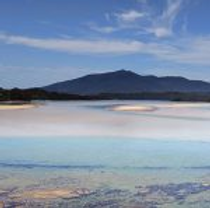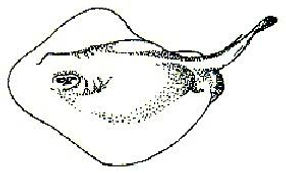Victor Harbor High Old Scholars
Dreaming Stories

Ngurunderi is one of the great ancestral Dreaming 'heroes' of the Ngarrindjeri people. The story of his exploits was known in detail by all of the different Ngarrindjeri groups at the time of European arrival in South Australia. The first published version of the Ngurunderi Dreaming appeared in an Adelaide newspaper in 1842, just six years after the colony of South Australia was proclaimed by the British.
Several versions of the Ngurunderi Dreaming have been recorded over the last 150 years, reflecting the emphases which different Ngarrindjeri groups placed (and still place today) on their local sections of this Dreaming.
This account is one from the last initiated Ngarrindjeri men. Albert Karloan, gave to the anthropologist Ronald Berndt in 1939 [Berndt 1940]. Like all the other version of the Dreaming however, this account stresses the over-arching importance of Ngurunderi as law-giver and as the main shaper of the distinctive landscape in which the Ngarrindjeri people still live today.
Below is a shortened version of this account. It can only provide a glimpse into the depth and complexity of the Ngarrindjeri oral translation. Richer sources exist for the reader, arising particularly out of the work of Norman B. Tindal and Ronald and Catherine Berndt.
The Ngurunderi Dreaming
In the Dreaming, Ngurunderi travelled down the Murray River in a bark canoe, in search of his two wives who had run away from him. At that time the river was only a small stream, below the junction with the Darling River.
A giant cod fish (Ponde) swam ahead of the Ngurunderi, widening the river with sweeps of its tail. Ngurunderi chased the fish, trying to spear it from his canoe. Near Murray Bridge he threw a spear, but missed and was changed into Long Island (Lenteilin). At Tailem Bend (Tagalang) he threw another; the giant fish surged ahead and created a long straight stretch in the river.
At last, with the help of Nepele (the brother of Ngurunderi's wives), Ponde was speared after it had left the Murray River and had swum into Lake Alexandrina. Ngurunderi divided the fish with his stone knife and created a new species of fish from each piece.
Meanwhile, Ngurunderi's two wives (the sisters of Nepele) had made camp. On their campfire they were cooking bony bream, a fish forbidden to the Ngarrindjeri women. Ngurunderi smelt the fish cooking and knew his wives were close. He abandoned his camp, and came after them. His huts became two hills and his bark canoe became the Milky Way.
Hearing Ngurunderi coming, his wives just had time to build a raft of reeds and grass-trees and to escape across Lake Albert. On the other side their raft turned back into the reds and grass-trees. The women hurried south.
Ngurunderi followed his wives as far south as Kingston. Here he met a great sourcer, Parampari. The two men fought, using weapons and magic powers, until eventually Ngurunderi won. He burnt Parampari's body in a huge fire, symbolised by granite boulders today, and turned north along the Coorong beach. Here he camped several times, digging soaks in the sand for fresh water, and fishing in the Coorong lagoon.
Ngurunderi made his way across the Murray Mouth and along the Encounter Bay coast towards Victor Harbor. He made a fishing ground at Middleton by throwing a huge tree into the sea to make a seaweed bed. Here he hunted and killed a seal; its dying gasps can still be heard among the rocks. At Port Elliot he camped and fished again, without seeing a sign of his wives. He became angry and threw his spear into the sea at Victor Habor, creating the islands there.
Finally, after resting in a giant granite shade-shelter on Granite Island (Kaike), Ngurunderi heard his wives laughing and playing in the water near King's Beach. He hurled his club to the ground, creating the Bluff (Longkuwar), and strode after them.
His wives fled along the beach in terror until they reached Cape Jervis. At this time, Kangaroo Island was still connected to the mainland, and the two women began to hurry across to it. Ngurunderi had arrived at Cape Jervis though, and seeing his wives still fleeing from him, he called out in a voice of thunder for the waters to rise. The women were swept from their path by huge waves and were soon drowned. They became the rocky Pages Islands.
Ngurunderi knew that it was time for him to enter the spirit world. He crossed to Kangaroo Island and travelled to its western end. After first throwing his spears into the sea, he dived in, before rising to become a star in the Milky Way.
Contact with Europeans began in about 1810 when sealers from Kangaroo Island kidnapped Ngarrindjeri women. These men introduced a variety of diseases to the Aboriginal population including smallpox, venereal disease and other diseases which had a devastating effect on the population.

Thukeri
The Bony Bream
Veena Gollan. Lake Alexandrina, South Australia, 1997
We are now at the site of the Thukeri story. In front of me is Lake Alexandrina. This part of the country belongs to the Ngarrindjeri people, it’s my people and it’s the site where the two Ngarrindjerri men went out fishing in their bark canoe.
A long time ago, the Ngarrindjeri people would have used their bark canoes to go fishing and to trade with other neighbouring groups along the Coorong and also, the Ngarrindjeri children would have spent a lot of time swimming and playing other games along this area.
Here is one part of the original school building that was built round about the time when the Mission was established in 1859. This church was erected by Reverend George Taplin and his role in the community was to protect Aboriginal people, so he thought he was protecting the Ngarrindjeri people, but what happened was the Ngarrindjeri people lost language, lost their right to practice their ceremonies, to pass on the laws to their young people.
Stories were lost because the Elders of the Ngarrindjeri nation could not pass on these stories and were told that you couldn’t practice your ceremonies, or do any of these important things for the culture to be taught.
What the children get from it is not just looking at how the characters look, but the information they get from the story. It tells of rules, gives them information about the environment as well as the spirit ancestor, Ngurunderi.
Behind is what’s left of the jetty. The Ngarrindjeri men used to shear the sheep and bring the sheep’s wool down onto the beachfront and then it would be baled up and taken by paddle steamer over to Goolwa and then transported to Adelaide.
This area was taken up for farming. The Ngarrindjeri people were very lucky to have all this water, because the Ngarrindjeri people were people who used the ocean and the water for fishing. There’s many different types of fish in Lake Alexandrina. We have Cape Barron Geese and swans, when the egg-laying season starts, the Ngarrindjeri people would go in their boats to go amongst the long bulrushes in the lake, where the swan would make its nest and they would take some of these eggs and eat them. We would also eat swan.
The Ngarrindjeri women came down here. There are long rushes that grow along the lakefront. They used these long rushes to weave carrying-baskets, big woven mats to sit on in their traditional camps and also the two Ngarrindjeri men who went fishing on Lake Alexandrina, they took with them a woven mat and a couple of woven baskets and they used these woven baskets to carry the Thukeri back to the camp.
This monument was erected by the young Ngarrindjeri men of the Mission. This commemorated the voyage of Captain Sturt down the River Murray. I think for the Ngarrindjeri people there wouldn’t have been any other significance to building it, other than an idea put forth by the missionaries.
For the Ngarrindjeri people, it’s very important that these stories are continued and the Thukeri story is told today in all South Australian schools. The story is very important because it teaches the young people about respect. It teaches about greed and lying and it also teaches about respect for your spirit ancestors, the creators of the Ngarrindjeri people and Ngarrindjeri lands.
I see it-as a Ngarrindjeri person-that, while we continue to tell the Thukeri story, our cultural beliefs will stay alive and that the young people-and
most importantly the Ngarrindjeri children-will have something that they can identify with.





Kondili
The Whale

(Source; Ngarrindjeri people and environment:Past Present & Future. DETE,2001)
The story begins when the Ramindjeri people had no fire and therefore had to dance in the daytime. It was very hot and their perspiration flowed forming the large ponds at Muthabaringga, in the valley of the Hindmarsh River. Their dancing feet formed the steep hills and the valleys.
The people knew that Kondili, the whale man, was the only person who had fire and they planned to obtain it from him. Two messengers, Kuratji ( Tommy rough man) and Kanmari (Mullet man) were sent to invite Kondili to a ceremony at Murthabaringga.
People came from all around to attend the meeting and prepare for the dancing. The dancing went on and on. When Kondili the whale danced, sparks flew from his body. When the others saw the fire they were excited and wanted some too.
Kondili was a large, powerful man and the others were afraid to approach him. Krilbali (the skylark man), said her would spear Kondili. Ritjurki( the wagtail man) said he would spear Kondili while Ngarankani, ( the shark) Mulori( the stingray) and Pungari (the seal) were dancing.
They called out to entice him, "Kondili, come and dance," Kondili danced while Ritjuruki (the wagtail) placed a spear into his spear thrower, Krilbali (the skylark) told Ritjuruki, "I'll spear Kondili.
A spear was thrown deep into the back of Kondili's neck through his jaw. Fire burst out. Kondili dived into the sea. The people cheered, but they were changed into animals, birds and fish. Some people became possums and those wearing feathers became cockatoos. Ngarankani, Mulori and Pungari joined Knodili in the sea.
Kondili came out of the sea at Pultung (Victor Harbor) and he rests at Latand (Hindmarsh River. Kondili now spouts water from the hole in his neck.
Kanmari had been dressed in a kangaroo skin and he became a fish now called mullet, an oily fish. Kuratji had been dressed in a seaweed mat and he became the small fish called Tommy rough which is dry and without much fat.
Krilbali, the skylark, ran around setting alight the surrounding grass, which turned to flints scattered over the ground. The flints are called Maki, and these can be used for making fire. A piece of flint is held together with dry fungus as tinder then hit with another Maki to make sparks which ignite tinder.
It is said that the fire went into the grass tree where it remained and can be used for making fire. One piece of flower stem is place on the ground with the flat side uppermost and another thinner piece is pressed on it whilst being rubbed between the hands backwards and forwards until it ignites. Every time you see a whale now spouting water, you can think of how Kondili's fire is now in Ramindjeri country.



